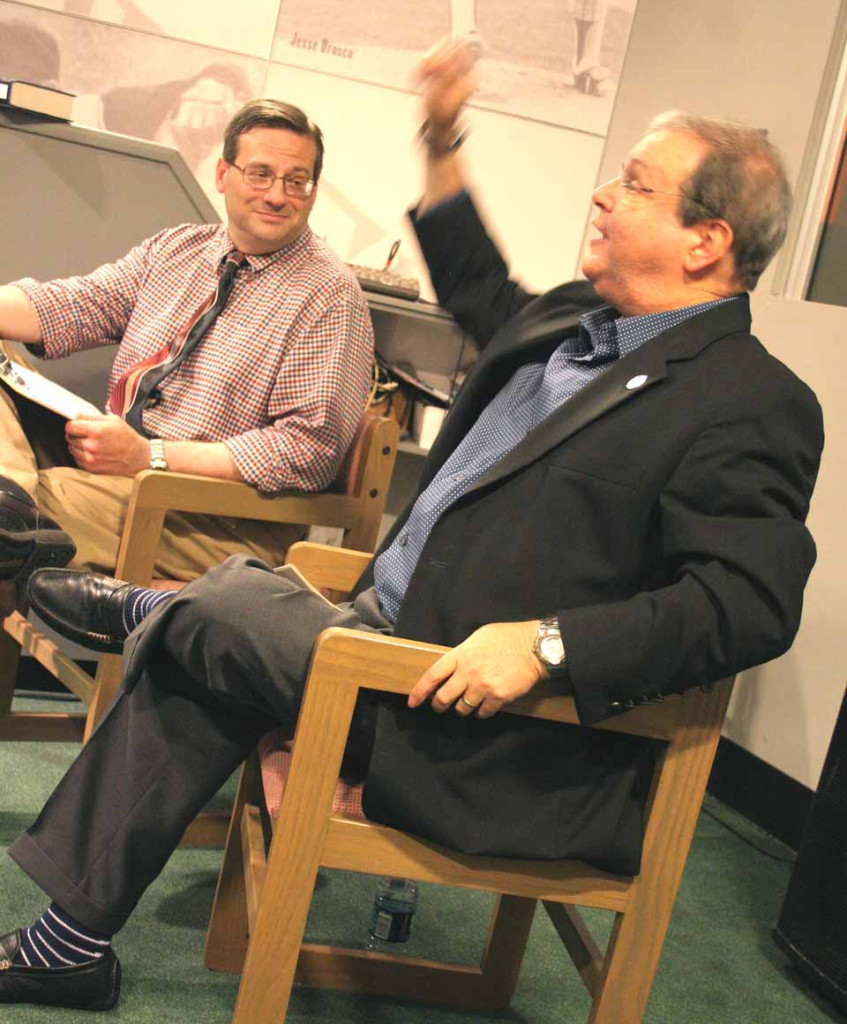From SUNY Oneonta To ‘The Mick’s’
Right-Hand Man And Baseball Career
By TERESA WINCHESTER • allotsego.com

COOPERSTOWN – “I cried when Babe Ruth died,” declared Marty Appel, prolific writer on sports-related topics, Emmy Award-winning producer, former Yankee public relations director, riveting raconteur, and SUNY Oneonta graduate.
“I was 9 days old,” added the author of the recently published “Pinstripe Empire,” a featured speaker at the Hall of Fame Friday, June 13, as part of the 75th anniversary celebration. He smiles and so does his audience.
READ AN EXCERPT FROM APPEL’S “PINSTRIPE EMPIRE”
With his broad, never-vanishing grin, a Saint Nick twinkle in his bespectacled eyes and an easy-going manner, Appel comes across as a man who derives great pleasure from his work.
Born in Brooklyn in 1948, Appel nonetheless has strong ties to both Cooperstown and Oneonta. Like millions of others, he first came to Cooperstown to visit the Hall of Fame in his early teens on a family vacation.
He was to return to the HoF many times – the trek made easier by his enrollment in SUNY Oneonta in 1966, where he majored in political science. His favorite teacher was Frank O’Mara, now professor emeritus. And O’Mara still recalls him with warmth and enthusiasm.
“He was a terrific student,” O’Mara, said. “There was never any question about his talent, brains and ability. And he knew he was going to work for the Yankees even though the Yankees didn’t know it.”
Appel’s smooth path to a highly desirable position with the Yankees smacks of manifest destiny. After his sophomore year, he wrote former Yankees public relations director Bob Fishel, asking simply for “a summer job.” He was then hired at a weekly salary of $100 to triage Mickey Mantle’s fan mail – Fisher having found “The Mick” to be highly remiss in writing back to his fans.
“I was in awe of Mickey Mantle and always had trouble having conversations with him,” said Appel.
One thing he admired about Mantle was that, in contrast to most of the more seasoned players, he always made a special effort to welcome rookies. Mantle himself had never forgotten nor forgiven Joe DiMaggio for the unfriendly – some would say “hostile” – treatment “Joltin’ Joe” had shown him.
In 1973, Appel, then 24, became the youngest public relations director in baseball, bringing him into close contact with players and their families.
He was the contact person for Babe Ruth’s widow, Claire, whenever she came to Yankee Stadium. He described her as a jovial lady who always greeted people at the stadium sweetly. When she died in 1976, Appel was one of her pallbearers. Her funeral, he said, was attended by scarcely more than a dozen people.
He was also familiar with another Yankee widow, Eleanor Gehrig, revealing that he habitually arranged to have “a little Johnny Walker” available at the stadium for both baseball wives.
Appel became fascinated with Babe Ruth’s legend early on.
“I was inundated with Babe Ruth, growing up in New York. There was something charming about his roguish ways,” said Appel. He particularly liked the opening line of Ruth’s autobiography: “I was a bad kid.”
Appel credits Ruth for the glamor associated with being a Yankee.
“There’s something magical about the lure of the uniform that Babe Ruth wore,” he said.
Appel points out that while all the other major sports have stand-out players for certain eras, Babe Ruth’s name endures as the all-time greatest baseball player.
Appel’s passion for history in general is evident in his 2012 Pinstripe Empire – a comprehensive narrative of baseball’s oldest, most colorful and most successful franchise.
After his talk, Appel signed copies of his book, now available in paperback at the Hall of Fame.
(Editor’s Note: This is a complete version of article that appeared in this week’s editions of The Freeman’s Journal and Hometown Oneonta that, due to a production issue, was cut short.)

